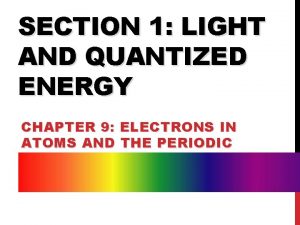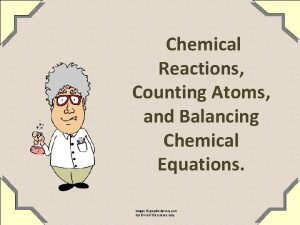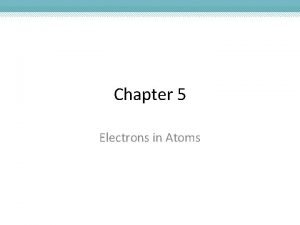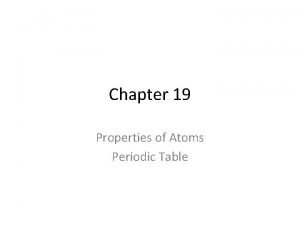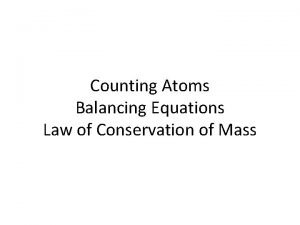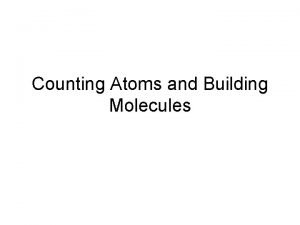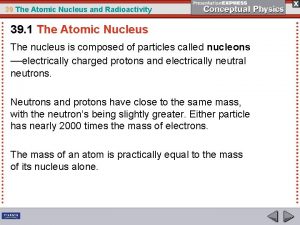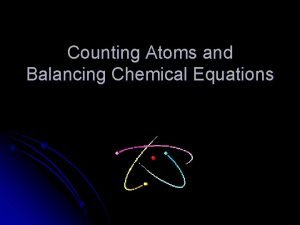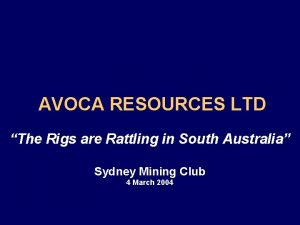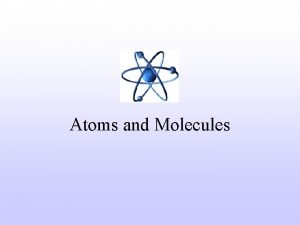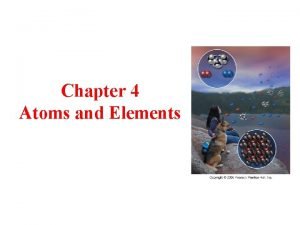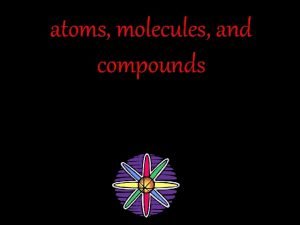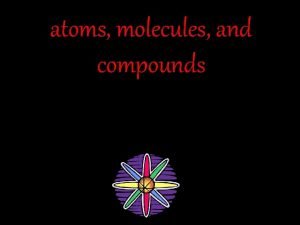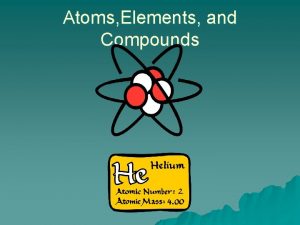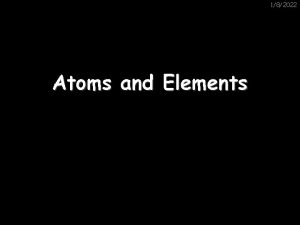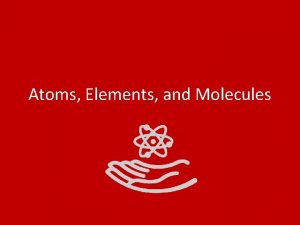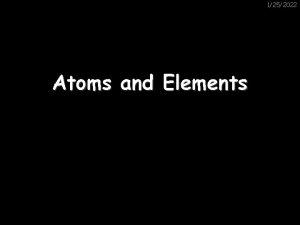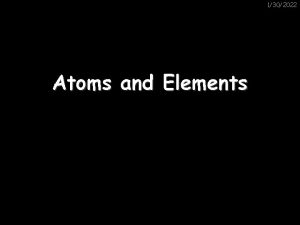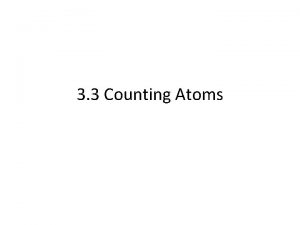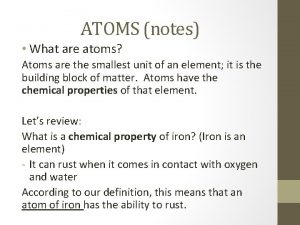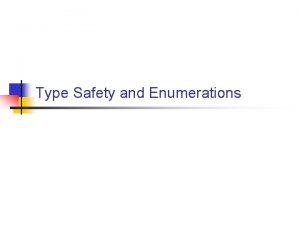Rattling Atoms in Type I and Type II





















- Slides: 21

Rattling Atoms in Type I and Type II Clathrate Materials Charles W. Myles, Texas Tech U. Jianjun Dong, Auburn U. Otto F. Sankey, 1 Arizona State U. March National APS Meeting Austin, TX, Tues. , March 4, 2003 1 Supported in part by NSF Grant NSF-DMR-99 -86706

• Si 46, Ge 46, Sn 46: ( Type I Clathrates) 20 atom (dodecahedron) “cages” & 24 atom (tetrakaidecahedron) cages, fused together through 5 atom rings. Crystal structure = simple cubic 46 atoms per cubic unit cell. • Si 136, Ge 136, Sn 136: ( Type II Clathrates) 20 atom (dodecahedron) “cages” & 28 atom (hexakaidecahedron) cages, fused together through 5 atom rings. Crystal structure = face centered cubic, 136 atoms per cubic unit cell.

Clathrates • Pure framework materials: Usually semiconductors. • Pure materials not easily fabricated. Normally have impurities (“guests”) encapsulated inside cages. Guests “Rattlers” • Guests: Group I atoms (Li, Na, K, Cs, Rb) or Group II atoms (Be, Mg, Ca, Sr, Ba) – Guests weakly bound in cages Minimal effect on electronic transport – Host valence electrons taken up in sp 3 bonds Guest valence electrons go to conduction band of host (heavy doping density). – Guests vibrate (“rattle”) with low frequency modes Strongly affect lattice vibrations (thermal conductivity)

Compensation • Guest-containing clathrates: Valence electrons from guests go to conduction band of host (heavy doping). Change material from semiconducting to metallic. • Sometimes compensate for this by replacing some host atoms in the framework by Group III atoms. Si 46, Ge 46, Sn 46 : Semiconducting Cs 8 Sn 46 : Metallic. Cs 8 Ga 8 Sn 38 : Semiconducting Si 136, Ge 136, Sn 136 : Semiconducting Na 16 Cs 8 Si 136, Na 16 Cs 8 Ge 136, Cs 24 Sn 136 : Metallic

Calculations • Computational package: VASP: Vienna Austria Simulation Package • First principles technique. – Many electron effects: Correlation: Local Density Approximation (LDA). Exchange-correlation energy: Ceperley-Adler Functional – Ultrasoft pseudopotentials. – Planewave basis • Extensively tested on a wide variety of systems • We’ve computed equations of state, bandstructures & vibrational phonon spectra.

• Start with given interatomic distances & bond angles. – Supercell approximation • Total binding energy minimized by optimizing internal coordinates at a given volume. – Interatomic forces to relax lattice to equilibrium configuration (distances, angles). – Schr dinger Eq. for interacting electrons, Newton’s 2 nd Law motion for atoms. • Repeat for several volumes until LDA minimum energy configuration is obtained. • Once equilibrium lattice geometry is obtained, all ground state properties can be obtained: – Vibrational dispersion relations: Our focus here! – Electronic bandstructures

Lattice Vibrational Spectra • Optimized LDA geometry: Calculate total ground state energy: Ee(R 1, R 2, R 3, …. . RN) • Harmonic Approx. : “Force constant” matrix: (i, i ) ( 2 Ee/ Ui Ui ), Ui = atomic displacements • Finite displacement method: Ee for many different (Small) Ui. Forces Ui. Dividing force by Ui gives (i, i ) & dynamical matrix Dii (q). Group theory limits number & symmetry of Ui required. • Positive & negative Ui for each symmetry: Cancels out 3 rd order anharmonicity (beyond harmonic approx. ) Once all unique (i, i ) are computed, do lattice dynamics. • Lattice dynamics in the harmonic approximation: det[Dii (q) - 2 ii ] = 0

Cs 8 Ga 8 Sn 38 Phonons C. Myles, J. Dong, O. Sankey, C. Kendziora, G. Nolas, Phys. Rev. B 65, 235208 (2002) Ga modes Cs guest “rattler” modes (~25 - 40 cm-1) “Rattler” modes: Cs motion in large & small cages

Raman Spectra Group theory determines Raman active modes. First principles frequencies, empirical intensities. C. Myles, J. Dong, O. Sankey, C. Kendziora, G. Nolas, Phys. Rev. B 65, 235208 (2002) Experimental & theoretical rattler (& other) modes in very good agreement!

• Reasonable agreement of theory and experiment for Raman spectrum. UNAMBIGUOUS IDENTIFICATION of low frequency (25 -40 cm-1) “rattling” modes of Cs guests in Cs 8 Ga 8 Sn 38 – Also: (not shown) Detailed identification of frequencies & symmetries of several experimentally observed Raman modes by comparison with theory.

Type II Clathrate Phonons With “rattling”atoms • Current experiments: Focus on rattling modes in Type II clathrates (thermoelectric applications). Theory: Given success with Cs 8 Ga 8 Sn 38: Look at phonons & rattling modes in Type II clathrates Search for trends in rattling modes as host changes from Si Ge Sn – Na 16 Cs 8 Si 136 : Have Raman data & predictions – Na 16 Cs 8 Ge 136 : Have Raman data & predictions – Cs 24 Sn 136: Have predictions, NEED DATA!

Phonons C. Myles, J. Dong, O. Sankey, submitted, Phys. Status Solidi B Na 16 Cs 8 Si 136 Na rattlers (20 -atom cages) ~ 118 -121 cm-1 Cs rattlers (28 -atom cages) ~ 65 - 67 cm-1 Na 16 Cs 8 Ge 136 Na rattlers (20 -atom cages) ~ 89 - 94 cm-1 Cs rattlers (28 -atom cages) ~ 21 - 23 cm-1

Si 136, Na 16 Cs 8 Si 136 Na 16 Cs 8 Ge 136 Raman Spectra 1 st principles frequencies. G. Nolas, C. Kendziora, J. Gryko, A. Poddar, J. Dong, C. Myles, O. Sankey J. Appl. Phys. 92, 7225 (2002). Experimental & theoretical rattler (& other) modes in very good agreement! Not shown: Detailed identification of frequencies & symmetries of observed Raman modes by comparison with theory.

• Reasonable agreement of theory & experiment for Raman spectra, especially “rattling” modes (of Cs in large cages) in Type II Si & Ge clathrates. UNAMBIGUOUS IDENTIFICATION of low frequency “rattling” modes of Cs in Na 16 Cs 8 Si 136 (~ 65 - 67 cm-1) Na 16 Cs 8 Ge 136 (~ 21 - 23 cm-1)

Cs 24 Sn 136 Phonons C. Myles, J. Dong, O. Sankey, submitted, Phys. Status Solidi B • Cs 24 Sn 136: A hypothetical material! Cs in large (28 atom) cages: Extremely anharmonic & “loose” fitting. Very small frequencies! Cs rattler modes (20 -atom cages) Cs rattler modes (28 -atom cages) ~ 25 - 30 cm-1 ~ 5 - 7 cm-1

Predictions • Cs 24 Sn 136: Low frequency “rattling” modes of Cs guests in 20 atom cages (~25 -30 cm-1) & in 28 -atom cages (~ 5 - 7 cm-1, very small frequencies!) – Caution! Effective potential for Cs in 28 -atom cage is very anharmonic: Cs is very loosely bound there. Calculations were done in the harmonic approximation. More accurate calculations taking anharmonicity into account are needed. Potential thermoelectric applications. NEED DATA!

Trend • Trend in “rattling” modes of Cs in large (28 -atom) cages as host changes Si Ge Sn Na 16 Cs 8 Si 136 (~ 65 - 67 cm-1) Na 16 Cs 8 Ge 136 (~ 21 - 23 cm-1) Cs 24 Sn 136 (~ 5 - 7 cm-1) • Correlates with size of cages in comparison with “size” of Cs atom.

Model for Trend • 28 -atom cage size in host framework compared with Cs guest atom “size”. • For host atom X = Si, Ge, Sn, define: Δr rcage- (r. X + r. Cs) rcage LDA-computed average Cs-X distance r. X (LDA-computed average X-X nearneighbor distance) covalent radius of atom X r. Cs ionic radius of Cs (1. 69 Å) (r. X + r. Cs) Cs-X distance if Cs were tight fitting in cage Δr How “oversized” the cage is compared to Cs “size”. Geometric measure of how loosely fitting a Cs atom is inside a 28 -atom cage.

Model • Simple harmonic oscillator model for Cs, with assumption that only Cs moves in its oversized 28 -atom cage. • Equate LDA-computed rattler frequency to: R = (K/M)½ K Effective force constant for rattler mode K A measure of strength (weakness) of guest atom-host atom interaction. M Mass of Cs

K vs. Δr • Smallest, Si 28 cage: Δr 1. 18 Å “oversized” K 2. 2 e. V/(Å)2 KSi-Si 10 e. V/(Å)2 Cs weakly bound • Ge 28 cage: Δr 1. 22 Å “oversized” K 0. 2 e. V/(Å)2 KGe-Ge 10 e. V/(Å)2 Cs very weakly bound • Largest, Sn 28 cage: Δr 1. 62 Å extremely “oversized” K 0. 02 e. V/(Å)2, KSn-Sn 8 e. V/(Å)2 Cs extremely weakly bound Largest alkali atom (Cs) in largest possible clathrate cage (Sn 28)!

Conclusions • LDA calculations of lattice vibrations • Type I clathrate: Cs 8 Ga 8 Sn 38 – Good agreement with Raman data for Cs rattler modes & also host framework modes! • Type II clathrates: Na 16 Cs 8 Ge 136, Na 16 Cs 8 Si 136 – Good agreement with Raman data for Cs rattler modes & also host framework modes! • Type II clathrate: Cs 24 Sn 136 (A hypothetical material) – Prediction of extremely low frequency “rattling” modes of Cs guests • Simple model for trend in Cs rattler modes (28 atom cage) as host changes from Si to Ge to Sn.
 At stp which substance is the best conductor of electricity
At stp which substance is the best conductor of electricity What is the relationship between atoms and elements
What is the relationship between atoms and elements Electrons in atoms section 1 light and quantized energy
Electrons in atoms section 1 light and quantized energy Atoms elements molecules and compounds worksheet
Atoms elements molecules and compounds worksheet Co2 + h2o c6h12o6 + o2
Co2 + h2o c6h12o6 + o2 Electrons in atoms section 1 light and quantized energy
Electrons in atoms section 1 light and quantized energy Properties of atoms and the periodic table
Properties of atoms and the periodic table What is the lowest allowable energy state of an atom
What is the lowest allowable energy state of an atom Mit center for bits and atoms
Mit center for bits and atoms Electrons in atoms section 2 quantum theory and the atom
Electrons in atoms section 2 quantum theory and the atom Counting atoms and balancing equations
Counting atoms and balancing equations 3bacl2 counting atoms
3bacl2 counting atoms Chemistry in biology section 2 chemical reactions
Chemistry in biology section 2 chemical reactions Chemistry in biology section 2 chemical reactions
Chemistry in biology section 2 chemical reactions Datación radiométrica
Datación radiométrica Counting atoms and balancing equations worksheet
Counting atoms and balancing equations worksheet Isotopes pogil
Isotopes pogil Atoms molecules and ions
Atoms molecules and ions Atoms molecules and ions
Atoms molecules and ions Chapter 6 section 1 atoms elements and compounds
Chapter 6 section 1 atoms elements and compounds Atoms molecules and ions
Atoms molecules and ions Atoms molecules and ions
Atoms molecules and ions


